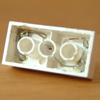Resurrecting This Old Amp update
 MAKE amends for 02! Page 116, 3b should read: “Reconnect the capacitor, switch the meter to DC voltage, turn off the input signal, and measure across the capacitor. Ours read 74 volts (V). The voltage rating on the capacitor is 75 volts, so there is not much margin in this old amp.” The title for the “Testing current/amperage” figure should be “Testing BFC current”. The title for “Testing Voltage” should be “Testing Output Current”. Link.
MAKE amends for 02! Page 116, 3b should read: “Reconnect the capacitor, switch the meter to DC voltage, turn off the input signal, and measure across the capacitor. Ours read 74 volts (V). The voltage rating on the capacitor is 75 volts, so there is not much margin in this old amp.” The title for the “Testing current/amperage” figure should be “Testing BFC current”. The title for “Testing Voltage” should be “Testing Output Current”. Link.




 Wow, this is one of the neatest projects I’ve seen lately- it’s a LEGO electronics lab kit. Using LEGO bricks, soldering nails, various electronic components to build an “Lego Electronic Lab Kit”. Check out all the photos on the site to see the different types of electronic-ified LEGOs and how they’re being used as all sorts of components.
Wow, this is one of the neatest projects I’ve seen lately- it’s a LEGO electronics lab kit. Using LEGO bricks, soldering nails, various electronic components to build an “Lego Electronic Lab Kit”. Check out all the photos on the site to see the different types of electronic-ified LEGOs and how they’re being used as all sorts of components. 
 Looks like a neat book. Build Your Own Earth Oven is a simple, fully-illustrated handbook for making a wood-fired, masonry-style oven out of inexpensive earthen materials (similar to adobe and cob). The book provides clear, step-by-step instructions for building and firing the oven, as well as complete directions for making sourdough bread in the best (and simplest) artisan tradition.
Looks like a neat book. Build Your Own Earth Oven is a simple, fully-illustrated handbook for making a wood-fired, masonry-style oven out of inexpensive earthen materials (similar to adobe and cob). The book provides clear, step-by-step instructions for building and firing the oven, as well as complete directions for making sourdough bread in the best (and simplest) artisan tradition. 


 …designed for being in the city walking. in the urban landscape less public space are provided for sitting down. public benches are being moved away or replaced with a ‘leaning pole’ but the need of sitting down remains. YOC serves both as a carrying bag and as a stool to be used while rambling, shopping, waiting or when ever you want to sit down. the stool is folded out of coated fibreboard and can be flattened when not in use.
…designed for being in the city walking. in the urban landscape less public space are provided for sitting down. public benches are being moved away or replaced with a ‘leaning pole’ but the need of sitting down remains. YOC serves both as a carrying bag and as a stool to be used while rambling, shopping, waiting or when ever you want to sit down. the stool is folded out of coated fibreboard and can be flattened when not in use. 
 Portable retro gaming! I use my Pocket PC quite a bit for games, mainly old NES titles on the PocketNester emulator. But the hardware buttons on the iPAQ are too small, and it can be hard to use certain combinations. My solution for this was to interface an original Nintendo controller to my PPC. For this mod, I used a cheap IR keyboard (Belkin F8U1500) and wired the directional keys and PPC hardware buttons (circled below) directly to the NES.
Portable retro gaming! I use my Pocket PC quite a bit for games, mainly old NES titles on the PocketNester emulator. But the hardware buttons on the iPAQ are too small, and it can be hard to use certain combinations. My solution for this was to interface an original Nintendo controller to my PPC. For this mod, I used a cheap IR keyboard (Belkin F8U1500) and wired the directional keys and PPC hardware buttons (circled below) directly to the NES. 
 DIY AC. …a student, with limited funds and a cheap house without air conditioning. To avoid dying this summer, I’ve built a primitive air conditioner. It’s a basic heat pump, using water as the medium. You’ll probably need to fiddle a bit with the dimensions of the supplies based on your resources and preferences. The system will cool an average room to a comfortable level in approximately 15-20 minutes. Depending on flow rate, a full bucket of water will last approximately 1-3 hours. It doesn’t rip quite as hard as central air, but for less than $30 CAD I’m not complaining. [
DIY AC. …a student, with limited funds and a cheap house without air conditioning. To avoid dying this summer, I’ve built a primitive air conditioner. It’s a basic heat pump, using water as the medium. You’ll probably need to fiddle a bit with the dimensions of the supplies based on your resources and preferences. The system will cool an average room to a comfortable level in approximately 15-20 minutes. Depending on flow rate, a full bucket of water will last approximately 1-3 hours. It doesn’t rip quite as hard as central air, but for less than $30 CAD I’m not complaining. [